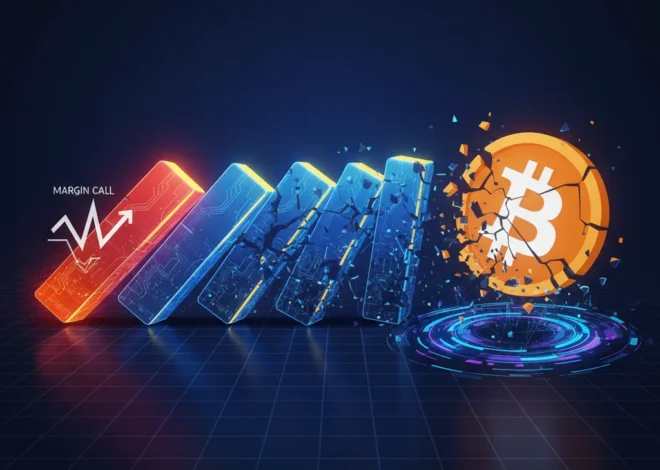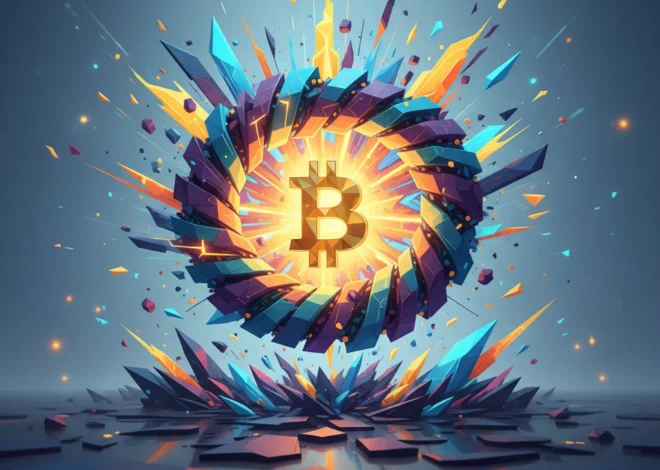
Bitcoin at a Crossroads: Why an AI Giant’s Earnings Could Ignite the Next Crypto Rally
The Quiet Before the Storm: A Market Holds Its Breath
In the intricate dance of global finance, seemingly disparate worlds often collide in spectacular fashion. This week, we stand at such a juncture. On one side, we have Bitcoin (BTC), the enigmatic king of cryptocurrency, flashing a potentially bullish signal after a period of consolidation. On the other, we have Nvidia (NVDA), the undisputed heavyweight champion of the artificial intelligence boom, poised to release earnings that could send shockwaves across the entire stock market. The air is thick with anticipation, as investors, traders, and financial professionals from both the traditional and digital asset worlds watch to see if the fate of a Silicon Valley titan will dictate the next major move for the world’s premier blockchain asset.
The convergence of these two events is no mere coincidence; it’s a powerful reflection of an increasingly interconnected financial ecosystem. Bitcoin, once lauded as an uncorrelated hedge, now often moves in lockstep with high-growth technology stocks, acting as a barometer for investor risk appetite. As we dissect the technical signals on Bitcoin’s chart and await the fundamental catalyst from Nvidia’s report, we are essentially trying to answer a multi-trillion-dollar question: Is the market ready to embrace risk again, or is a flight to safety imminent? This analysis will explore the critical technical pattern forming for BTC/USD, the profound implications of Nvidia’s performance on the broader economy, and what it all means for your investment strategy in this volatile landscape.
Decoding the Chart: Bitcoin’s Bullish Hammer
For those engaged in the art and science of trading, price charts tell a story. Each candle is a chapter, revealing the battle between buyers and sellers over a specific period. Recently, a particularly compelling character has emerged on Bitcoin’s daily chart: the “hammer candle.” As noted in a recent analysis from Investing.com, this pattern formed as Bitcoin tested, and subsequently rejected, lower price levels, closing near its opening price.
But what exactly is a hammer candle, and why does it excite technical analysts? A hammer is a single-candle pattern characterized by a small body at the top of the trading range and a long lower wick, which should be at least twice the size of the body. It signifies that during the period, sellers pushed the price down significantly, but a surge of buying pressure (the “bulls”) stepped in to drive the price back up, closing near the high. It’s a visual representation of a potential capitulation by sellers and a resurgence of buyers, often signaling a bottom or a reversal of a downtrend.
To better understand this signal, let’s compare it with other key candlestick patterns that traders frequently monitor.
| Pattern Name | Appearance | What It Suggests |
|---|---|---|
| Hammer (Bullish) | Small upper body, long lower wick. Appears after a downtrend. | Sellers tried to push the price down but failed as buyers stepped in. Potential bullish reversal. |
| Inverted Hammer (Bullish) | Small lower body, long upper wick. Appears after a downtrend. | Buyers attempted a rally that was faded by sellers, but the failure of sellers to push the price lower can be a sign of exhaustion. Potential bullish reversal. |
| Hanging Man (Bearish) | Looks like a hammer but appears after an uptrend. | Significant selling pressure emerged during the session, even though buyers pushed it back up. A warning of potential weakness. |
| Shooting Star (Bearish) | Looks like an inverted hammer but appears after an uptrend. | Buyers pushed the price up, but sellers took control and forced it back down. Potential bearish reversal. |
While the appearance of a hammer candle is a promising sign for Bitcoin bulls, it’s crucial to remember that no single indicator is infallible. Confirmation is key. Traders will be watching for follow-through in the subsequent trading sessions—a strong green candle, for instance—to validate the reversal signal. The pattern’s reliability is also enhanced when it forms at a significant support level, such as the psychologically important $60,000 mark that Bitcoin has been defending. This technical setup provides the context, but the catalyst for a confirmed move may come from an entirely different sector of the market.
The Trillion-Dollar Blind Spot: Is the Private Credit Boom Hiding a Ratings Crisis?
The AI Bellwether: Why Nvidia’s Report Resonates Across All Markets
To understand why a semiconductor company’s quarterly report holds so much sway over the price of a decentralized digital currency, we must look at the current state of the global economy and investor psychology. Nvidia is no longer just a graphics card company; it has become the primary engine of the artificial intelligence revolution, a trend so powerful it has single-handedly driven stock market gains over the past 18 months. The company’s performance is now seen as a proxy for the health of the entire tech sector and, by extension, a key indicator of overall market sentiment.
The logic follows a clear path:
- Nvidia’s Earnings: If Nvidia reports earnings and forward guidance that exceed Wall Street’s already lofty expectations, it validates the massive investment and hype surrounding AI.
- Market Sentiment: This positive confirmation would likely boost the entire stock market, especially the tech-heavy Nasdaq. It signals to investors that the growth story is intact and encourages a “risk-on” attitude.
- Capital Flows: In a risk-on environment, capital flows out of safer assets (like bonds and cash) and into assets with higher potential returns. This includes growth stocks, emerging markets, and, increasingly, cryptocurrencies like Bitcoin.
Conversely, a disappointment from Nvidia could have a chilling effect. A miss on revenue or a cautious outlook could suggest the AI boom is slowing, potentially triggering a broad market sell-off. In this “risk-off” scenario, investors would likely flee to safety, and speculative assets like Bitcoin could face significant downward pressure. This deep-seated link between the performance of leading technology firms and the broader financial technology space highlights an evolving market dynamic where traditional and digital asset classes are more intertwined than ever (source).
The Macroeconomic Maze: Beyond a Single Stock and Coin
While the Bitcoin hammer and Nvidia’s earnings create a compelling short-term narrative, they exist within a much larger macroeconomic framework that influences all investment decisions. Central banking policies, inflation data, and geopolitical stability form the bedrock upon which market sentiment is built. The U.S. Federal Reserve’s stance on interest rates remains a dominant force. Persistent inflation could force the Fed to maintain higher rates for longer, which typically acts as a headwind for risk assets by making safer investments like government bonds more attractive.
Recent economic data has sent mixed signals, contributing to the market’s current state of indecision. A strong labor market suggests a robust economy, but stubbornly high inflation figures complicate the path forward for monetary policy. This uncertainty is precisely why a major fundamental catalyst, like a blockbuster earnings report from a market leader, can have such an outsized impact. It provides a moment of clarity—or confusion—that can set the market’s direction for weeks to come. Investors in every corner of the finance world, from Wall Street trading floors to decentralized finance (DeFi) platforms, are watching these developments, understanding that the ripples from one part of the economy can quickly become waves in another.
The current market environment is a testament to the complex interplay of technical analysis, corporate fundamentals, and macroeconomic trends. According to the original analysis, the technical setup for Bitcoin is leaning bullish, but this signal requires a fundamental spark to ignite a sustainable move as per Investing.com. Nvidia’s earnings report is poised to be that spark.
Conclusion: A Pivotal Moment for Investors
We are at a fascinating intersection of technical patterns, corporate performance, and macroeconomic forces. Bitcoin’s bullish hammer candle suggests a potential bottom is in, signaling that buyers are ready to defend key support levels. However, this technical optimism hangs in the balance, awaiting a fundamental catalyst to either validate or invalidate it. That catalyst is Nvidia’s earnings report, an event that has transcended a single company to become a referendum on the AI revolution and a barometer for the market’s overall risk tolerance.
For investors and business leaders, the path forward requires a multi-faceted approach. It’s no longer enough to be a specialist in just one asset class. Understanding the connections between the stock market and the world of fintech and blockchain is essential for navigating modern financial markets. Whether Nvidia’s results propel Bitcoin to new highs or the bullish hammer fails in a wave of risk-off sentiment, the coming days will be a masterclass in the interconnectedness of our global economy. Watch the charts, listen to the earnings call, but most importantly, understand the powerful forces that tie them together.


